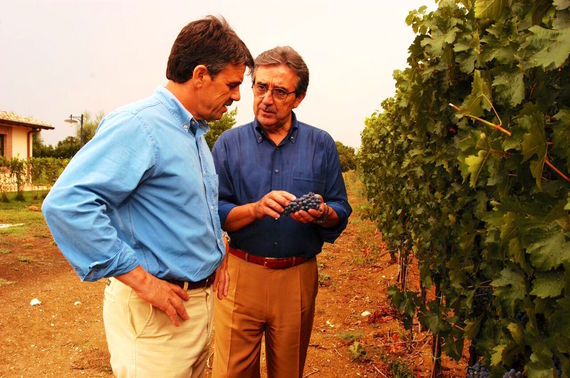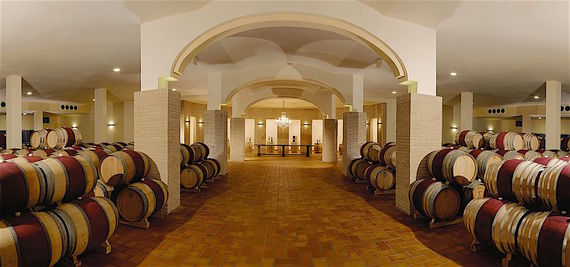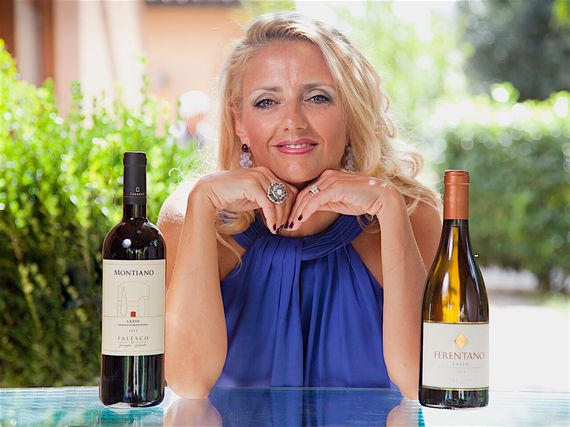If you mention the words "Lazio" and "wine" in the same breath to the average oenophile, chances are the response will be a shrug, even an admission of ignorance about a region that has never enjoyed a reputation for its wine. Which is all the more surprising because the capital of the region, also known as Latium, is Rome, which gathers to it all that is best in Italy.

Yet, despite Lazio having 27 DOC zones, the only ones wine lovers are likely to know are Frascati, Castelli Romani and Est! Est!! Est!!!--the latter because of its embroidered story of how a 12th century German bishop on his way to Rome instructed a servant to go before him to find inns with good wines and to write the Latin word "Est" ("it is") on the door of the best. The legend goes on to say the servant found the wines of Montefiascone in Lazio so good that he wrote the word three times, with additional exclamation points.
Still, despite such stories, and even with 3 DOCG-rated wines (Cesanese del Piglio, Cannellino di Frascati and Frascati Superiore), the region's wines are not taken very seriously, despite a production of 19 million cases annually, with the majority of varietals being Malvasia (30%) and Trebbiano (28%).

Well aware of Lazio's viticultural reputation, the relatively new Falesco estate, founded by brothers Renzo and Riccardo Cotarella (right) in Montefiascone in 1979, dedicated itself to bring the region's wines into the 20th century and beyond. Ten years later they had produced a well-regarded Est! Est!! Est!!! called Poggio del Gelsi, made from Malvasia and Trebbiano, and adding Roscetto grapes, followed by a slew of other wines--Sagrantino, Syrah, Aleatico--that would eventually include varietals from Umbria, where they built a new winery.

The brothers were convinced that dismissed varietals like Trebbiano had a real future, which had already been proven by a handful of producers in the eastern province of Abruzzo. Joining their efforts were their daughters, Marta, Dominga and Enrica (below), along with their husbands, and the estate's reputation rose rapidly for making solid, very fresh white wines that enhanced all the Lazio varietals' reputation, and they set out to make their winery a place for wine tourism via professionally guided visits. The company was also aggressive in supplying wines to prestigious events like the Internazionali BNL d'Italia at the Foro Italico in Rome. And by the first decade of the current century, Falesco's wines were winning top ratings from guides like Veronelli, Bibenda and Gambero Rosso, even garnering the Sakura Women's Wine Award in Japan.

Perhaps Falesco's canniest decision has been to send Dominga Cotarella (below), marketing manager, (center in the photo) to premier wine markets around the world, for she is possessed of great beauty and a fierce commitment to her family's wines, both virtues I found irresistible over dinner with her at NYC's Eleven Madison Park, where she was showing off Falesco's flagship Montiano, an IGP red wine made from 100% Merlot. The very fact that Falesco would try to make a red wine to compete with the great estates of Tuscany and Piedmont showed a formidable Italian spunk, but, as Dominga explained, "We wanted to be compared not just with the best in Italy but the best anywhere."

To that end--in the spirit of the famous Paris blind tasting of French crus against California wines in 1976, where the latter bested several of the former--Falesco held a blind tasting of two Montiano vintages, 2007 and 2013, in Milan this year, its 20th anniversary, alongside one of the most prestigious wines in the world, Pétrus 2007, also made from 100% Merlot from Saint-Émilion.
"The results surprised everyone but ourselves," said Dominga. "Many at the tasting thought the Montiano surpassed Pétrus."
If the results did not cause quite the international thunderclap the Paris tasting did forty years ago, it became clear that Montiano, of which 50,000 bottles are produced annually (Pétrus makes 30,000), was deserving of high applause, and the wine has become much sought after. At our dinner, which was highly eclectic, with a menu that didn't match up easily with any wine, the Montiano showed its remarkable depth with dishes like foie gras marinated with strawberry and black pepper, ribeye of beef with eggplant, and a Hudson Valley Camembert. There were several layers of flavors in balance with one another in the wine, which was very clearly a soft Merlot, a varietal that gives off lovely, subtle spices.
"Our Merlot is grown in an old, low-yielding vineyard," said Dominga, "and the soil is volcanic, so the minerality is in the forefront. The grapes were selected very rigorously for their health, intensity and flavor. The juice was fermented in stainless steel vats after a long maceration time--18 days--then transferred to French barriques, where the malolactic was carried out, then aged for 18 months."

It is the softness of Merlot that prevents Montiano's 14.5% alcohol level from being too hot on the palate, or too plummy in the finish. It is certainly a wine that will grow in stature over the next five years. And at $50 a bottle--especially when a current vintage of Pétrus will run you between $600 and $900--the 2013 Montiano's value comes into to even clearer focus.
As for the future of Falesco, Dominga said, "We would like to continue to produce great red wines that are truly an expression of the terroir. We are working with Syrah and our plan is to create wines that are in the Falesco style: elegant, fruity, fragrant and full of personality with really, soft harmonic tannins."
FALESCO FAMILY OF LAZIO AND UMBRIA AIMS TO BE A GLOBAL PLAYER IN WINE
FALESCO FAMILY OF LAZIO AND UMBRIA AIMS TO BE A GLOBAL PLAYER IN WINE
This post was published on the now-closed HuffPost Contributor platform. Contributors control their own work and posted freely to our site. If you need to flag this entry as abusive, send us an email.
